The Divine Lance: Thaipusam and Murugan Worship in Singapore
Thaipusam speaks of a migratory community that carries its deep-rooted cultural tradition wherever its people go.
By Nalina Gopal
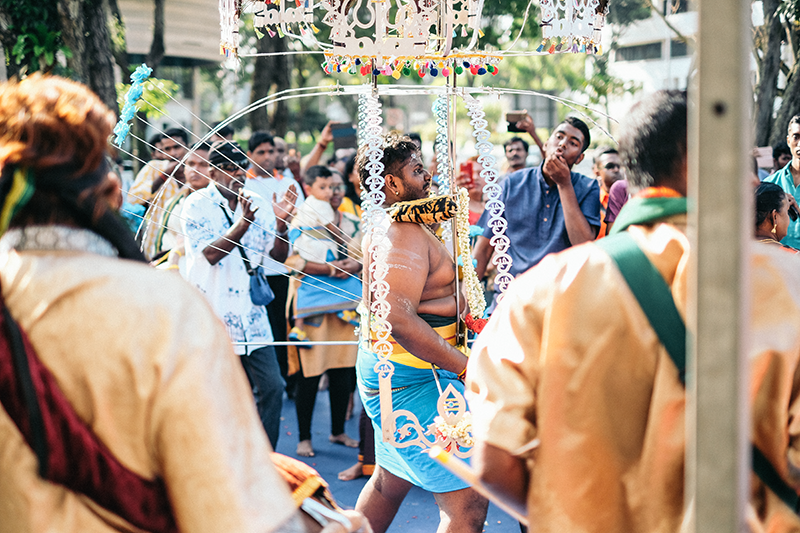
On 9 February 1952, the Singapore Free Press carried a story titled “No ‘Kavadis’ Today”.1 That year, Singapore’s Tamil community scaled down Thaipusam celebrations and refrained from holding the procession because of the death of King George VI. That was an unprecedented event. Since then, there hasn’t been such another instance of Thaipusam being put on hold, that is, until 2021 when the procession in Singapore was disallowed because of the Covid-19 pandemic.
Thaipusam personifies the worship of Murugan, a celebrated patron god in Tamil tradition who has been revered for over two millennia. Taking place during Thai, the 10th month in the Tamil calendar (January to February in the Gregorian calendar), Thaipusam is celebrated in South India, and outside it, by the Tamil diaspora in Singapore, Malaysia, Mauritius, South Africa, Sri Lanka, Indonesia, Myanmar and even Australia.
In Singapore, the festival is one of the most distinguishing features of diasporic Hindu practice and one of the earliest public Hindu festivals. Worshippers, including carriers of milk pots and kavadi, exemplify their devotion to Murugan in an annual 4-kilometre foot procession.2 The festival is a reflection of a journey that spans over 160 years, growing beyond its orthodoxy, in cross-cultural Singapore.
The God with a Lance
மாயோன் மேய காடுறை உலகமும்
சேயோன் மேய மைவரை உலகமும்
வேந்தன் மேய தீம்புனல் உலகமும்
வருணன் மேய பெருமணல் உலகமும்
முல்லை குறிஞ்சி மருதம் நெய்தல் எனச்
சொல்லிய முறையான் சொல்லவும் படுமே
the pastoral region, presided over by Mayon;
the mountain region, presided over by Ceyon;
the riverine region, presided over by Ventan;
the great sandy (coastal) region, presided over by Varunan;
these, in the order enumerated, are called mullai, kurinci, marutam and neytal.3
Thaipusam is centred around the worship of Murugan. The boy god Murugan’s identity is a complex mix of several inseparable historical and cultural roots, and a reflection of the inherent complexity of Tamil tradition. Tamil poetry of the Sangam era (a period spanning roughly 3rd century BCE to 3rd century CE) positions Murugan (or Murukan from the word muruku meaning “beautiful”, “fragrant” or “youthful one”) as the god of the hills and hunt,4 and the son of Korravai, goddess of war and victory.5
Murugan was a name originally given to the god of the hilly region Kurinci.6 In the Tolkappiyam, the oldest extant Tamil grammatical text, he is described as Ceyon or the red one due to the association of the ruddy hills of the region with his skin tone.
The Murugan of Sangam literature – a considerable corpus of classical devotional and literary works – has a peacock for his mount and wields a lance or vel, after which his priests and the chieftains of the hills, the velan (“bearer of the lance”), were named.
By the 5th century CE, Murugan’s attributes were fused with those of Skanda (also known as Karthikeya, Subrahmanya and Kumara), a god found in the literature of the Epic period of the north (when the Ramayana and Mahabharatam were composed).7 Devotional compositions authored by Saivite poet-saints around the 7th century CE incorporated him into the Saivite pantheon and worshipped him as the son of Siva. (Followers of Siva are called Saivites.)
Murugan’s roots in a long and rich Tamil cultural heritage is perhaps one of the reasons why he is a recipient of unwavering faith, celebrated across the global Tamil diaspora.
A Myth Celebrated
திரிய விட்டெறிந்து,
நோயுடை நுடங்கு சூர் மா முதல் தடிந்து
You swirled your weapon
and destroyed Sur[an], personified fear, who had taken the form of a moving mango tree8
Perhaps the most central myth in Murugan worship involves him vanquishing the demon Sur or Suran, a myth known as early as the 1st century CE.9 In preparation for the battle, he is presented with a vel by Sakti, the wife of Siva. The day he was given the invincible vel is celebrated as Thaipusam (named after the day in which the Pusam star is exalted in the month of Thai).
With his vel, Murugan destroys Suran by splitting a huge mango tree into two, the mango tree being the form that the shape-shifting Suran had taken. Suran then assumes the form of a peacock and a cockerel, with the former eventually becoming Murugan’s vehicle while the latter is a symbol subsumed in his flag.
Dating back to the 3rd century CE, the Tirumurugarrupadai, the oldest devotional poem of the Sangam era dedicated to Murugan, lists the arupadaiveedu or six abodes of Murugan: Tiruttani, Swamimalai, Tiruchendur, Tiru Avinankudi (widely known as Palani), Pazhamudircholai and Tirupparamkunram.
Thaipusam commemorates Murugan receiving the vel from Sakti, while a separate festival, Kanda Sashti, marks the defeat of the demon Suran. These events are linked with Tiruchendur, the location where Suran was defeated. However, the specific form of Murugan worship during Thaipusam is associated with the legends at Palani. Palani is a hill temple site where Murugan is enshrined as Dandapani (also Dandayudapani or Thendayuthapani), a young ascetic who holds a staff, exemplifying mastery of the self.
The story goes that a young Murugan, angry with his parents for their judgement of a competition in favour of his sibling, retreats to the top of a nearby hill to do penance. Petulant at the loss of the award, a divine fruit, he is consoled by being told “pazham ni” (“you are the fruit”) from which the hill town of Palani derived its name.
It is while in penance on this hill abode that Murugan meets the demon Idumban, seen as the primordial kavadi bearer.
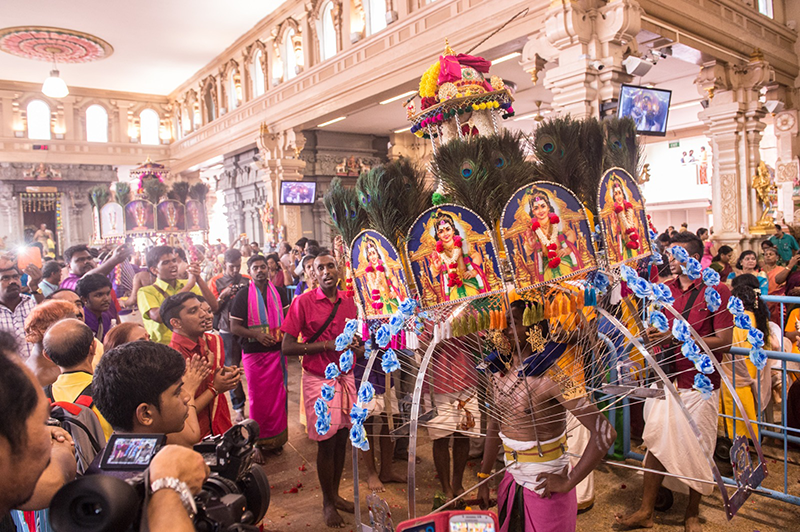
In the myth, Idumban’s teacher, Saivite seer Agastya, enlists Idumban’s help to carry two hills, Sivagiri and Saktigiri, from the north to the south for Siva’s southern abode.
Idumban ties the two hills to a celestial staff using divine serpents in the place of ropes, and carries the two hills on the staff that acts like a shoulder pole, a prototype for a kavadi. Enroute, tired by his burdened journey, he lays the hills down for a rest but finds he is unable to lift them when ready to depart. He sees a boy-ascetic, who is in fact Murugan, atop one of the hills and confronts him without realising his divine identity.
Murugan destroys Idumban but eventually revives and installs him as the door guardian for his abode. Murugan cites Idumban’s arduous kavadi journey as a method for his worshippers to propitiate him. This myth has become the quintessential format for a unique ritual worship of Murugan.10 The Idumban kavadi or the shoulder pole is a fundamental kavadi type still carried by devotees today.
It is this surrender of a burden (of arrogance and ignorance) to Murugan, emulating the example of the primeval devotee, Idumban,11 that the annual foot procession of thousands of kavadi-bearing devotees in Singapore (and around the world) exemplifies.
The Red One in the Red Dot
சிங்கை காக்கும் குக முருகா
Guhan, Muruga, the guardian of Singapore12
– A line from hymn 88 in the Singai Nagar Antati
The celebration of Thaipusam in Singapore can be traced to the Nattukottai Chettiars, who became an influential diaspora of private financiers in Southeast Asia in the 19th century.13 They adopted Murugan as their patron deity in their diasporic homes and as a partner in their business ventures, and their settlement pattern typically involved the construction of Murugan temples. When boarding a ship, the pioneering migrants carried the vel of Murugan, transferring their burden of worry for safe passage to the deity with the words “Murugan tunai” (“Murugan protects us”).14
In 1858, Nattukottai Chettiars installed the vel of Murugan beneath a pipal tree, beside a water tank, at the foot of a hill at the junction of Tank Road and Clemenceau Avenue.15 (According to collective memory, the vel was worshipped for around 30 years before the establishment of their temple.16) By 1859, the Sri Thendayuthapani Temple was built nearby on land obtained from Thomas Oxley, with its design and layout based on the Murugan temple in Penang, an architectural template that would be adopted across the region by the merchant bankers.17
While this temple on Tank Road is dedicated to Thendayuthapani, inspired by the Palani god, the vel is accorded primary space during temple rituals even today. The austerity of the god and his lone, self-disciplined stance was an exemplar to a migrant community of single men who had left home and family in search of opportunity in a foreign land.
Within a year of the temple’s establishment, the festival of Thaipusam began to be observed in Singapore. A three-day celebration complete with a silver chariot procession and spectacular fireworks,18 the festival was a public holiday from 1879 until 1914, when members of the community led by N. Veerasamy petitioned to have the more widely observed Deepavali declared a day off instead.19 Despite the cessation of the holiday, some banks would still be closed, mail delivery unavailable and cinema shows at the YMCA cancelled in lieu of the processional celebration.20
In the late 19th century, the festival would commence with the Chettiars issuing a general invitation to all residents to attend the festival of Thaipusam held at their temple on Tank Road.21
Typically, on the day before Thaipusam, a silver chariot procession known as Punar Pusam (named after the star in ascendance on the day) would be undertaken in the morning from the Sri Thendayuthapani on Tank Road to the Layan (Sepoy Lines) Sithi Vinayagar Temple (also maintained by the Chettiars) on Serangoon Road. The chariot or ter was drawn by cattle up to the 1970s. The cattle was then replaced by a motorised vehicle.
.png)
In the evening, kavadi bearers carrying the traditional semi-circular wooden burdens would trail the returning chariot procession conveying the utsava murti, or processional image of Murugan, via Market Street. They were all men from the Nattukottai Chettiar community, thus earning the event the name – Chetti Pusam.
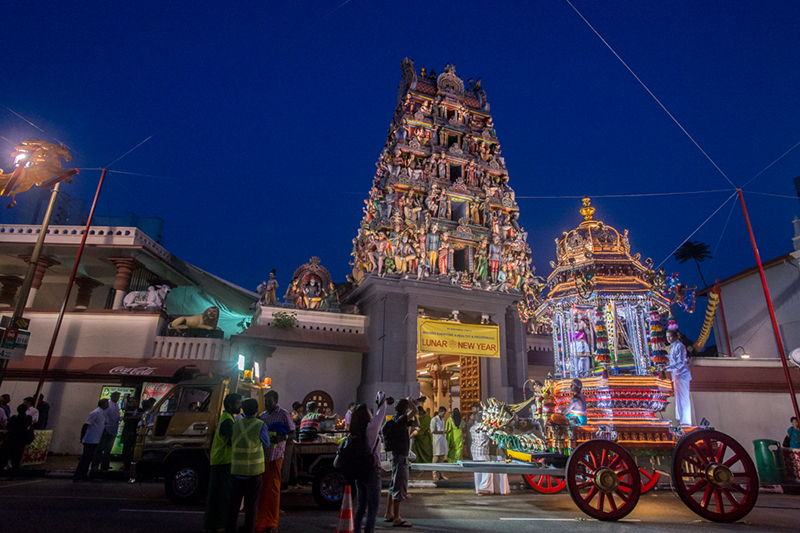
.png)
A 1938 letter from Sockalingam Chettiar of Market Street addressed to the chief police officer provides an insight into the extent of arrangements made for the festival.22 Anticipating a huge crowd of devotees for a period of three days (15 to 17 January), the letter made very specific requests for police personnel, such as asking for Sikh corporals and sergeants, and Tamil police constables. It also identified the three crucial components of the festival:
“[A] silver car starting not later than 8.30 am from Tank Road Temple… to Keong Saik Road and after a short display of daylight fireworks there till noon, will return to Tank Road Temple starting at about 6 pm via Market Street. … On Sunday, the 16th January, from morning till midnight the devotees will gather round the Tank Road Temple premises… On Monday, the 17th January, a religious procession of kavadi will go round the temples at Tank Road and Orchard Road [the Sivan temple located at Dhoby Ghaut then]… the last and the huge procession again starting from Tank Road will proceed to Raffles Reclamation ground, Beach Road, where there will be a grand display of fireworks…”23
As can be seen from the above excerpt, in 1938, the Thaipusam procession of kavadi bearers would also visit the erstwhile Sri Sivan temple on Orchard Road, a temple closely associated with the Nattukottai Chettiars. The procession over the three days would have a presence across the districts of present-day Chinatown, the Central Business District (including Market Street), Clemenceau, Orchard Road, and even Beach Road.
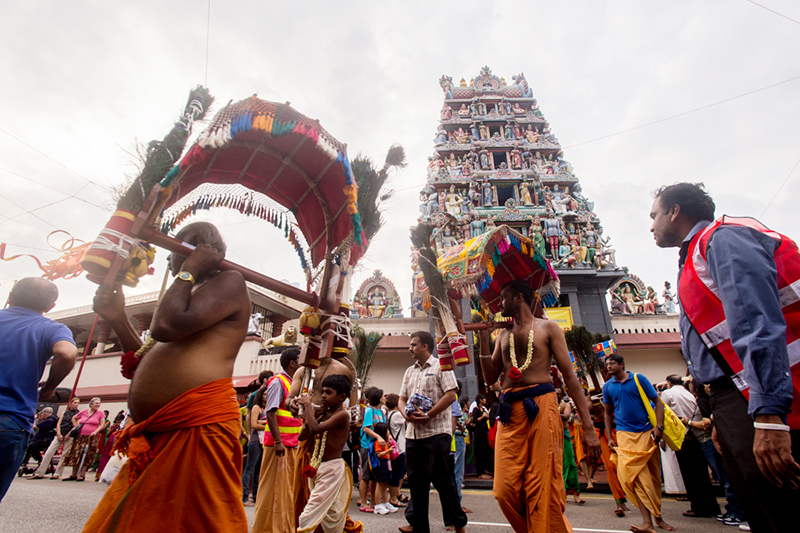
In 1932, the Sri Thendayuthapani Temple acquired a new and bigger silver chariot, but it could not be used because it was too tall to fit below the Traction Co.’s trolley bus wires along the way.24 The chariot was only used when motor buses replaced trolley buses.
In 2019, Satthappan Chettiar, then 74, recalled his earliest memory of the festival. Dolls were manoeuvered above Market Street by men stationed in the upper storey of kittangi (warehouse and place of work of the Chettiar merchant bankers) on either side of the street, such that as the silver chariot went past, the dolls would descend with garlands to honour Murugan.
He said: “The deity would be seated on the silver chariot, drawn by bulls through Market Street. … one person would be stationed on the second floor of one of the kittangi, and one more on the second floor of the opposite shophouse, facing the kittangi. They would each hold on to one end of a rope; a doll holding out a garland would be suspended from the middle of this rope. The two men would swing the doll back and forth in a dance, and when the chariot appears below the doll, the doll would descend with the garlands, and ‘place’ the garlands on Lord Murugan’s shoulders, to loud cheers.”25
Devotion on Display
In the early years, the kavadi foot procession would begin from any of the Hindu temples across Singapore. Eventually, however, the starting point came to be the Sri Srinivasa Perumal Temple on Serangoon Road for the purpose of convenience. The foot procession would then depart from that temple to Tank Road, spanning a route approximately 3 to 4 km. Tourism brochures would promote this annual and public Hindu observance.26
From the eve of the festival, devotees arrive progressively at the Sri Srinivasa Perumal Temple, finding a suitable spot to aid their preparations for carrying the kavadi, either independently or in groups.
On the day of Thaipusam, they begin their preparation early in the morning. Following cleansing rituals, the kavadi are arranged in an altar-like format on the ground, with offerings placed on banana leaves filled with aromatics and offerings. Then comes the penetration of the needles, which is undertaken by devotees in a state of utmost concentration, equated at times to a trance.27
The kavadi bearers depart at dawn on the foot procession, moving to rhythmic chants of Vel Vel or Vel Muruga Vel, walking at at steady pace until they reach the Sri Thendayuthapani Temple. There, their pace quickens in anticipation of the culmination of their journey of devotion.
The offering of milk or honey, usually incorporated into vessels ensconced within the kavadi, are offered as ablutions to Murugan when devotees end their foot procession at the Sri Thendayuthapani Temple. Devotees subsequently hold a ceremony in their homes to honour Murugan and sometimes perform a rite known as Idumban Puja, usually within three days of Thaipusam. Idumban Puja is also known to be performed by some Chinese kavadi bearers in Malaysia.28
Worship, Ritual and Aesthetics
Penitents carry the kavadi to fulfil their vow of devotion for protection during a time of great tribulation. While the kavadi is strongly associated with Thaipusam, it is not exclusive to the festival. The firewalking festival of Theemithi, dedicated to the mother goddess as well as Panguni Uttiram, a festival celebrating Murugan’s celestial wedding, have also seen devotees engaging in a worship ritual involving the kavadi.29
The kavadi can take many forms. A simple thol kavadi has semi-circular wooden poles decorated with peacock feathers and a cloth canopy carried on the shoulder. An alagu kavadi (beautiful sharp-edged kavadi) is a more elaborate form including a stainless steel or aluminium framework bedecked with peacock feathers and other colourful materials, supported by a belt and shoulder pads,30 relating to the practice of self-mortification.
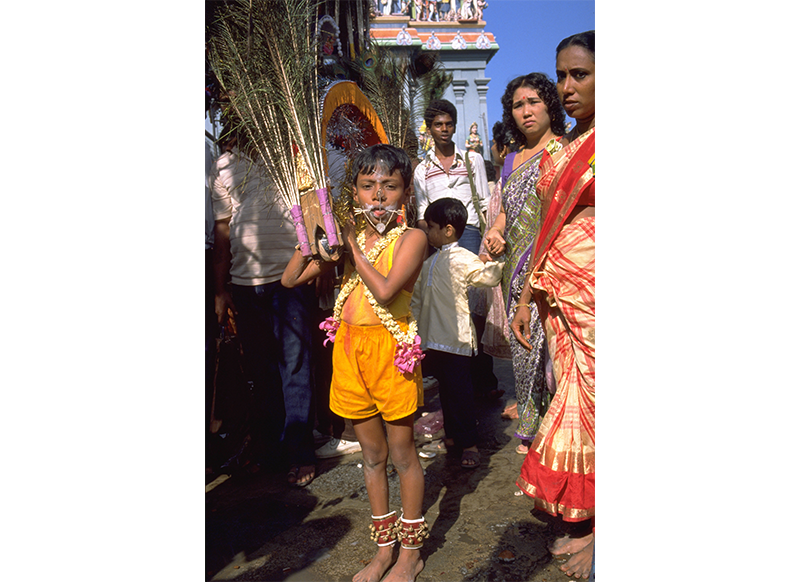
The paal kudam or milk pot burden is carried by around tens of thousands of devotees annually in Singapore,31 including women and children, offering some opportunity for balance in an otherwise gendered processional space.
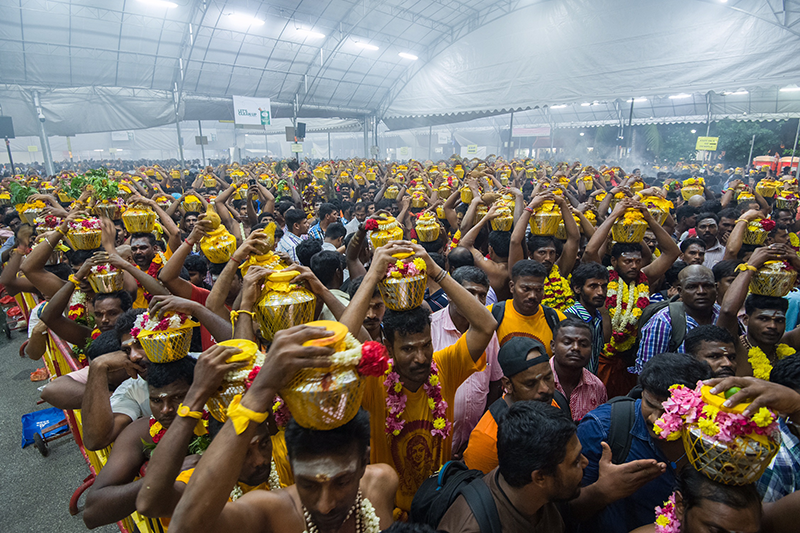
The concentration of the devotee on Murugan is the focus of the kavadi that involves piercings. The alavu kavadi involves the piercing of the tongue or cheek with a vel to prevent the devotee from speaking during the walk of faith. The alagu kavadi, on the other hand, involves the penetration of the skin of the bearer with needles or spikes, while the ratha kavadi involves the devotee pulling a chariot that is attached to their back.
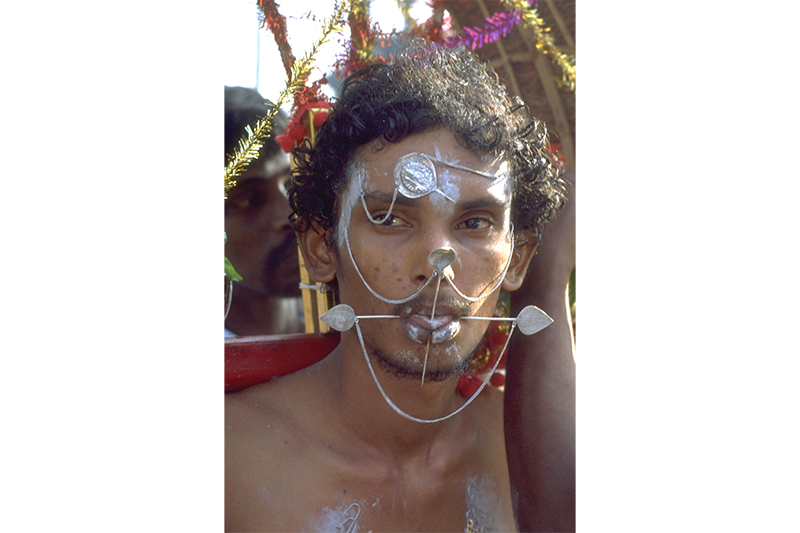
The alagu kavadi, meaning “beautiful kavadi”, gets its name because of how it looks and its tendency to attract the most attention during the festival. In 2009, the devotee R. Sharuhasan’s alagu kavadi weighed around 35 to 40 kg and had a total height close to two storeys when lifted. The peacock features were each about 90 cm long, and the kavadi was designed to evoke those carried by his uncles some 20 years ago. “I didn’t aim for it to be the biggest kavadi that day, but rather to carry on the family tradition,” he said.32

S. Kalleychelbon, who has been carrying the kavadi after being hospitalised with a knee injury, was reported in the Straits Times in 1990 as saying that he would typically fast for 48 days before carrying the chariot kavadi, which was modelled after the silver chariot of Murugan at Palani.33
In 2016, Prethev Raj carried the arigandam kavadi in which four stainless steel rods pierced his waist to hold the kavadi sans belt.34 Veeraraghaya Naidu carried a similar kavadi in 1990, but in addition, he walked with clogs embedded with nails, mimicking Idumban’s arduous foot journey to Palani.35
From the late 1930s, Tamil organisations helming the Self-Respect Movement raised protests regarding self-mortification. In view of the banning of piercings in Madras (now Chennai), the Sri Thendayuthapani Temple forbade the alagu kavadi in 1950, only to retract its decision by end of the year in the face of prodigious opposition from devotees.36
Some view the devotee as the processional vehicle and the kavadi as a personification of Murugan’s shrine. Another school of thought is that the kavadi is an embodiment of the human form occupied by the devotee, with the wooden structure being a metaphor for the skeleton, the cloth canopy for skin, and so forth.37
It is also customary for the kavadi bearer to be accompanied by family and friends chanting the names of Murugan or singing “Kavadi Sindu”. This is sung by the accompanying ensemble to spur the devotee on. Part of a special musical genre attributed to the poet, Annamalai Reddiyar, the verses have an odd number of lines rendered in alternating slow and fast tempos, a mesmerising metre that aids the devotee in retaining focus through rhythmic movements. 38
An early version of “Kavadi Sindu” composed and sung in Singapore is the “Singainagar Singara Vadivelar kavadi Sindu”, written by R.M.R. Ramanathan in 1907. It is dedicated to the deity at Sri Thendayuthapani Temple addressed as “Thendayutha, Kadamba”, asking him to protect the kavadi bearers.39
The ban and seizure of musical instruments used during Thaipusam began in 1973. In 2017, for the first time in over 40 years, the government allowed live music during the street procession but stipulated that people could only play specific instruments like the nadhaswaram (a wind instrument), a barrel-shaped drum called the tavil and the urumi melam (Indian drum).40 Music is important to the devotee. “With the beat and the singing, I bounced while walking and the bounce of the kavadi took the weight off me,” longtime kavadi bearer Subash Gunaseelan told the Straits Times in 2019. “In the past, without any music, the journey felt very long and we had to rush. Now, the music makes carrying the kavadi enjoyable as well.”41
Interestingly, the regulation of musical instruments during Thaipusam has a long history in Singapore. In 1896, colonial police confiscated the drums of the band of the Maharaja of Travancore, which had been engaged to perform for the Thaipusam festival.42
Celebrations by the Tamil Diaspora and Other Communities
In 1860, when Thaipusam was first celebrated in Singapore, South Africa saw the emergence of Murugan worship. The observance of a 10-day kavadi festival included the hallmark carrying of the traditional wooden kavadi.43 In Mauritius, the carrying of the kavadi involving piercing is also undertaken, not unlike in Singapore and Malaysia.44
It is not uncommon to see those of diverse faiths and ethnicities undertaking the pilgrimage. As early as 1966, the Straits Times carried an interview with Lim Ewe Chia, a Chinese kavadi bearer from Penang who said that he vowed to carry the kavadi if his family was cured of asthma. Apparently, none of his family members suffered any attack that year. “I consider this a miracle,” he said.45
The idea of not confining devotion to one transcendental deity has spurred some Chinese Buddhists and Taoists to participate in Thaipusam. Some of them even enter a trance. This is more common in Malaysia, notably in Penang, than it is in Singapore.

It is also not unusual to see worshippers from Singapore attend the festivals in Penang or Batu Caves. The latter is Malaysia’s foremost pilgrimage site of Murugan worship and receives up to 400,000 visitors annually during the chariot procession.46 Thaipusam has been observed at the caves since 1892, and here the festival and its environment bear the closest resemblance to the observance at the Palani hill temple in Tamil Nadu.
In Phuket, the celebration of the nine-day Taoist festival dedicated to the Nine Emperors sees penitents with spikes in their faces and walking on hot embers to display their devotion to deities. These practices are inspired by the festivals of Thaipusam and Theemithi.
Thaipusam, of course, continues to be celebrated in South Asia, in Palani (and across Murugan temples in the region) and Katargama in Sri Lanka.
The festival of Thaipusam is a phenomenon tying together source and diasporic communities, particularly those that were part of a modern wave of migration across colonial settlements. This age-old festival is a long-surviving cultural umbilical cord of inescapable historical and social significance, that also extends beyond ethnic and religious boundaries.
 Nalina Gopal is an independent curator and researcher focused on South Asia and its diaspora. She is the founder of Antāti, a historical research and museum consultancy.
Nalina Gopal is an independent curator and researcher focused on South Asia and its diaspora. She is the founder of Antāti, a historical research and museum consultancy.NOTES
-
“No ‘Kavadis’ Today,” Singapore Free Press, 9 February 1952, 1. (From NewspaperSG) ↩
-
The etymology of the word Thaipusam has been offered as (a) காவு (sacrificice)- + தடி (pole or stick) by the University of Madras Tamil Lexicon, taken to mean a pole or stave of wood used for carrying burdens; or (b) as காவு+ அடி, taken to mean sacrifice at every step, perhaps a reference to Idumban’s arduous and burdened journey. ↩
-
Subbiah Ganapathy, “Patterns in Religious Thought in Early South India: A Study of Classical Tamil Texts” (PhD thesis, McMaster University, Ontario, August 1988), 64. https://macsphere.mcmaster.ca/bitstream/11375/15543/1/Subbiah Ganapathy.pdf. ↩
-
Fred W. Clothey, “Pilgrimage Centers in the Tamil Cultus of Murukan”, Journal of the American Academy of Religion 40, no. 1 (March 1972): 80. (From JSTOR via NLB’s eResources website). ↩
-
Kamil V. Zvelebil, Tiru Murugan (Chennai: International Institute of Tamil Studies, 1981), 69, Tamil Digital Library, https://www.tamildigitallibrary.in/book-detail?id=jZY9lup2kZl6TuXGlZQdjZt9lZh3&tag=Tiru%20Murugan#book1/. ↩
-
Uli Kozok, A 14th century Malay Code of Laws: The Nitisarasamuccaya (Singapore: ISEAS Publishing, 2015), 107–108. (From National Library, Singapore, call no: RSEA 499.280959813 KOZ) ↩
-
Clothey, “Pilgrimage Centers in the Tamil Cultus of Murukan,” 81. ↩
-
Translation referenced from Zvelebil, Tiru Murugan, 32; and Vaidehi Herbert’s translations of Sangam poetry, “Sangam Poems Translated by Vaidehi,” accessed 20 September 2022, https://sangamtranslationsbyvaidehi.com. [The Paripadal, the fifth of the Eight Anthologies (Ettuthokai), dating to the 5th to 6th century CE, contains one of the earliest collection of hymns dedicated to Murugan. The Eight Anthologies is a classical Tamil poetic work that forms part of the Eighteen Greater Texts (Pathinenkilkanakku) in Sangam Literature.] ↩
-
Zvelebil, Tiru Murugan, 30. ↩
-
Carl Vadivella Belle, “Thaipusam in Malaysia: A Hindu Festival Misunderstood?” (PhD Thesis, Deakin University, Victoria, 2004), 71. ↩
-
Clothey, “Pilgrimage Centers in the Tamil Cultus of Murukan,” 90. ↩
-
Singai Nagar Antati is a collection of one hundred devotional hymns written by Yazhpanam S.N. Sadasiva Panditar, published in Singapore in 1887, and dedicated to the presiding deity of the Tank Road Thendayuthapani Temple. ↩
-
For information about the Chettiars, see Marcus Ng, “Micro India: The Chettiars of Market Street,” BiblioAsia 13, no. 3 (Oct–Dec 2017). ↩
-
Subbiah Lakshmanan, personal communication, 16 September 2022. He recounted the anecdotal experience of early migrants and how integral Murugan worship was to their diasporic journeys. ↩
-
A. Palaniappan, “Arulmigu Thandayuthapani Temple, Singapore, Sri Thandayuthapani Temple Singapore,” Maha Kumbabishegam Magazine (Singapore: Sri Thandayuthapani Temple, 1996), 1. ↩
-
Subbiah Lakshmanan, “The Chettiar Legacy in Singapore” (unpublished manuscript), retrieved on 19 September 2022, Microsoft Word. ↩
-
Lakshmanan, “The Chettiar Legacy in Singapore.” ↩
-
For an account of the rituals spanning five days during the festival, see “தைப்பூசத்திருவிழா,” Singai Nesan Tamil Journal, 6 February 1888, 1. (rom NewspaperSG) ↩
-
Bala Baskaran, Said Abdullah and Arun Senkuttuvan, V.R. Nathan: Community Servant Extraordinary (Singapore: Institute of Southeast Asian Studies, 2012), 39–40. (From National Library, Singapore, call no. RSING 361.25092 BAL) ↩
-
“Page 4 Advertisements Column 4,” Straits Times, 17 January 1935, 4; “No Delivery of Mails on Thaipusam,” Straits Times, 24 January 1964, 18; “Untitled,” Straits Times, 10 February 1922, 8. (From NewspaperSG) ↩
-
“Page 2 Advertisements Column 3: Tai-pusam,” Singapore Free Press and Mercantile Advertiser, 28 January 1896, 2. (From NewspaperSG) ↩
-
Letter from S. Sockalingam Chettiar to the Chief Police Officer, 3 January 1938, Collection of the Sri Thendayuthapani Temple Library, 1–2. I am grateful to Subbiah Lakshmanan for showing me this and other rare materials in the collection of the library. ↩
-
“Letter from S. Sockalingam Chettiar to the Chief Police Officer,” 1. ↩
-
“Thaipusam. Celebration of the Festival in Singapore,” Straits Times, 23 January 1932, 12. (From NewspaperSG) ↩
-
S. Sathappan Chettiar, “Tales of Thaipusam”, Singapore Memory Project, 15 July 2019, https://www.singaporememory.sg/contents/SMA-acca3114-b0a5-4b48-abb2-0bbbaf9f8622. ↩
-
Vineeta Sinha, New God in the Diaspora?: Muneeswaran Worship in Contemporary Singapore (Singapore: Singapore University Press; Copenhagen S., Denmark: NIAS Press, 2005 ), 3. (From National Library, Singapore, call no. RSING 294.5095 957 SIN) ↩
-
Sinha, New God in the Diaspora?, 9–11. ↩
-
Kartheges Ponniah and Kingston Pal Thamburaj, “Chinese Community’s Involvement in Thaipusam Celebration at Sungai Petani Sri Subramaniya Swami Devasthanam,” Man in India 97 (January 2017): 17–25, ResearchGate, https://www.researchgate.net/publication/328979416_chinese_community’s_involvement_in_thaipusam_celebration_at_sungai_petani_sri_subramaniya_swami_devasthanam. ↩
-
For information about Theemithi, see Nalina Gopal, “Theemithi: A Look at the Full Cycle of Rituals Behind the Festival of Firewalking,” BiblioAsia 18, no. 3 (October–December 2022). ↩
-
Lawrence A. Babb, Thaipusam in Singapore: Religious Individualism in a Hierarchical Culture ([Singapore]: Chopmen Enterprises, [1976]), 9. (From National Library, Singapore, call no. RSING 294.536 BAB) ↩
-
“More Than 10,000 Devotees Take Part in Thaipusam,” Straits Times, 3 February 2015, https://www.straitstimes.com/singapore/more-than-10000-devotees-take-part-in-thaipusam. ↩
-
Tamilavel, “Tall Order for this Kavadi Carrier,” Tabla!, 13 February 2009. ↩
-
Prabhavathi Nair, “The Two Faces of Thaipusam,” Straits Times, 2 February 1990, 8. (From NewspaperSG) ↩
-
“Preparing for the Walk,” Hindu News (2016: Hindu Endowments Board: 2016), 4. ↩
-
Nair, “The Two Faces of Thaipusam.” ↩
-
Vineeta Sinha, Religion-state Encounters in Hindu Domains: From the Straits Settlements to Singapore (Dordrecht: Springer, 2011), 216–20. (From National Library, Singapore, call no. RSING 322.1095957 SIN) ↩
-
Carl Vadivella Belle, Thaipusam in Malaysia: A Hindu Festival in the Tamil Diaspora (Singapore: ISEAS-Yusof Ishak Institute, 2017), 273. (From National Library, Singapore, call no. RSEA 294.53609595 BEL) ↩
-
Alison Arnold ed., The Garland Encyclopedia of World Music: South Asia: The Indian Subcontinent vol. 5 (New York; London: Routledge, 1998–2002), 921. (From National Library, Singapore, call no. RSEA 780.9 GAR) ↩
-
A copy is available at the library of the Sri Thendayuthapani Temple. ↩
-
Melody Zaccheus, “Singapore Government to Allow Live Music at Thaipusam Street Procession,” Straits Times, 19 January 2016, https://www.straitstimes.com/singapore/singapore-government-to-allow-live-music-at-thaipusam-street-procession. ↩
-
Shabana Begum, “Devotees Cheer New Rules That Allow More Music During Thaipusam Procession,” Straits Times, 21 January 2019, https://www.straitstimes.com/singapore/devotees-cheer-new-rules-that-allow-more-music-during-thaipusam-procession. ↩
-
“Confiscated Drums,” Singapore Free Press and Mercantile Advertiser (Weekly), 4 February 1896, 13. (From NewspaperSG) ↩
-
Thillayvel Naidoo, “Kavadi: Worship Through Ceremonial Festival,” Religion in Southern Africa 2, no. 2 (July 1981): 3–11. (From JSTOR via NLB’s eResources website). ↩
-
Belle, Thaipusam in Malaysia, 278. ↩
-
“Miracle, He Said, So Mr. Lim Joins Kavadi Bearers,” Straits Times, 5 February 1966, 20. (From NewspaperSG) ↩
-
Belle, Thaipusam in Malaysia, 246. ↩

